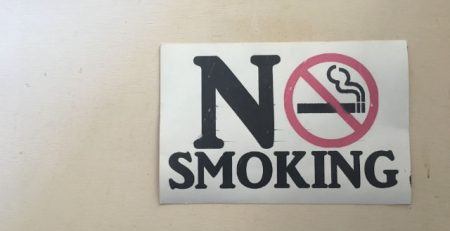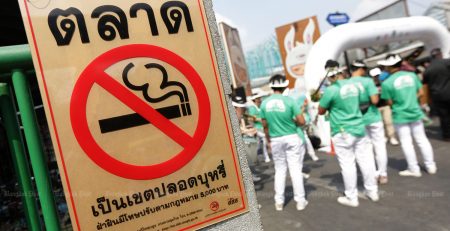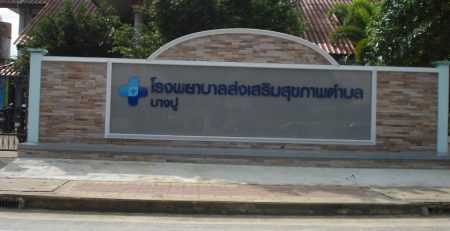Inburi Hospital, Singburi province
Inburi Hospital, Singburi province www.inburi.net
The size of Inburi hospital is about 218 beds and it provides health service to the general public who live in Amphur Intraburi and Amphur Bangrachan. The beginning of a smoke – free hospital for this hospital has started by finding leaders of all departments to participate in a smoke – free hospitals activities.
For the internal work, all work systems in this hospital have been involved. The Outpatient Department (OPD) is the first unit to start working on smoke – free hospital activities, followed by the Emergency department. The Emergency department started its work processes according to the Hospitals policy, a smoke – free hospital as well as smoking policies. There were many activities that have been processed in this hospital for being a smoke – free hospital such as establishing public relations, building network relationships, promoting health promotion to the hospitals staff, selecting new staff from those who are concerned about the harms of cigarettes for themselves and other people, and developing cigarette cessation clinics. Moreover, Inburi hospital also expanded its service hours, posted signs inviting smokers to quit smoking, applied 5A to the staffs routine work and also increased knowledge to serviced communities.
For the external work of this hospital, the public relations has been carried out by creating public relations signs posted in areas up to 200 meters away from the hospital. The proactive working method was launched in education places, communities and temples surrounding this area.
The slogan of Inburi Hospital, Singburi Province : Work is driven effectively because Inburi Hospital, Singburi province has good team leaders.
Telling Story
The background of being a smoke – free hospital for Inburi hospital was established by a nurse who worked in the Department of Psychiatry. Being concerned with the establishment of a smoke free hospital, she asked for permission to work to establish a 100 % Smoke – free hospital. Team leaders started to survey causes of real problems occurring with cigarettes for the hospital. The findings showed that the hospital was not much more concerned about the harms of cigarette smoking than in the past, and also did not provide additional health services to its patients. For these reasons, the hospital provided trainings for its hospital staff. However, these trainings did not provide successful results. Then, a new method was carried out, finding leaders from all departments to drive activities to become a smoke – free hospital. There were 34 leaders participating in these activities and those leaders helped in driving policies to sort out smoking health problems in each department in the hospital. Those leaders worked with staff who smoked using a method to help them understand about harms of cigarette smoking, and advised those staff smokers to quit smoking. The elements of this activity emphasized the participation of all departments in the hospital led by leaders. Moreover, this activity was carried out in neighboring communities via schools, public health services and temples. The public relations methods used for these activities were media campaigns and announcements.
What were the results of these activities
Policy: There was a combination of policy and operations in the hospital that emphasized the participation of all departments in their operations including preventing new initial smokers, smoking cessation, and restoring health due to the negative effects of smoking.
Processes:
- Set environmental management by establishing a smoke – free hospital and posting announcements that this is a smoke – free hospital.
- Create public relations such as (1) survey staffs opinion (2) announce policy of being a 100% smoke free hospital in written form (3) post announcement of a smoke – free hospital (4) expand this knowledge to communities (5) give voice announcements, exhibit and orient patients and relatives when they come for treatment at the hospital.
- Establish a network leader; for example, set meetings, find volunteers, provide workshop trainings, and develop assessment tools used for screening patients.
- Encourage quitting smoking starting from smoking staff, provide quit smoking services, and evaluate the quit smoking results during year 1 (which showed that 7 in 21 people could quit smoking).
- Develop a service system in order to provide and encourage quitting smoking to smoking staff and patients. All staff in hospital applied 5A to their routine work starting by asking patients about their smoking history; provided knowledge according to opportunities available, and collect problems occurring in work performance.
- Develop clinics to provide service, post invitation signs, and expand more hospital service hours to Monday Friday during 08:30 -16:30.
Lessons learnt from the Smoke – free hospital activities that could be applied for further benefits
- After making announcement of a 100 % Smoke free hospital, some hospital staff protested this announcement. For this reason, it was necessary to provide more understanding to those staff and also inform them of the purpose of these hospital activities.
- Moreover, many staff understood that smoke – free hospital activities would increase their work. For this reason, it was essential to clarify with all staff about this matter. The effective methods used for insuring good understanding among hospital staff were to perform work performance via their leaders in order to brain storm, expand knowledge, and reflect upon the problems occurring.
- Policy should be announced early in order to inform everyone clearly to prevent misunderstanding and to encourage working on these activities as building happiness while working.
Activity, Problem and Obstacle
- Staff was not confident with carrying out their work performance at the beginning of activities. This could be sorted out by providing more advice to those staff.
- Some hospital staff concerned that it was difficult to make those activities successful because there were many patients visiting the hospital and also new patients did not know policies and how to sort out problems with hospital staff. So, closely and continually monitoring results could provide better results.
- The proactive work was not been designed to work throughout communities, so it was unable to response to the needs of communities. The solution could be sorted out by providing basic knowledge trainings and help in collaborating work and monitoring of smoking cessation.
- In the first step, hospital staff did not cooperate and they also protested these activities of a smoke – free hospital. The solution is to inform them up front that a smoke – free hospital is a required hospital policy. Making understanding among hospital staff that a smoke – free hospital is not enforcement and encourage them to quit smoking in order to be a good example to patients and encourage them to quitting smoking.
- In the first step, hospital staff were concerned that smoke – free hospital activities were chosen only by leaders. A meeting to encourage all staff to collaborate in smoke-free activities and participate in quitting smoking was needed to resolve this misunderstanding
- Leaders were tired and felt they had no more power to carry out work on smoke – free hospital activities. A collaboration with bosses could be developed and so leaders do not have to work too hard on all the activities. Moreover, it should be asked for permission from the executives to get distilled lessons from places outside the hospital so leaders could be more relaxed.
- The budget was limited while more work needed to be carried out on improving work performance.
- Natural disasters delay the work performance on smoke free hospital activities.
- Monitoring was quite hard because seniors do not have cell phones and no return letters were sent to those seniors.
Suggestion
- Building networks and monitoring systems for cigarette cessation in hospitals and health care places should be established in order to provide support continually, and also take good care of old people in communities by family members or community leaders. Those could also help smokers to quit smoking.
- Work performance must be expanded to hospital staff in order to participate in these activities.
- Smoking cessation services for patients in the hospital should also let patients relatives participate in the smoking cessation services.
Reported by: Inburi Hospital
Summarized by: Ms. Sarinya Laohapunpong, Inburi Hospital, 2008, Inburi Hospital, Singburi province. Work is driven effectively because Inburi Hospital, Singburi province has good team leaders. Krongjit Vathesatogkit (Editor) Smoke – Free Hospital Model: Distilled Hospital, 3-23 Bangkok: Action on Smoking and Health Foundation Thailand.












